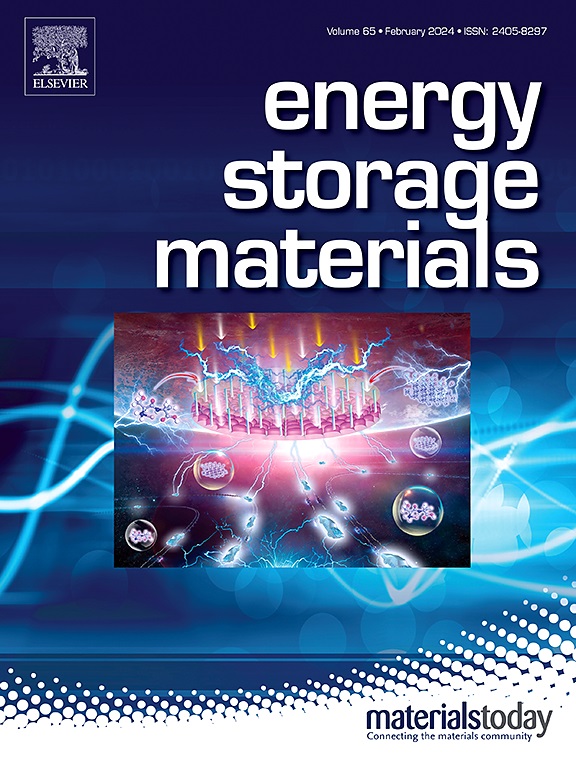稳定锌金属阳极电解液仿生离子泵的设计
IF 20.2
1区 材料科学
Q1 CHEMISTRY, PHYSICAL
引用次数: 0
摘要
锌金属阳极在非均质离子分布的驱动下枝晶生长,限制了其在高能量密度电池中的应用。在这里,我们开创了液态金属有机框架(MOF)作为一个内置的仿生离子泵进入电解质,不像传统的固体MOF,以稳定锌金属阳极。UiO-66液态MOF的固有孔隙以及含氧原子与Zn2+之间的强静电相互作用,可以有效地促进Zn2+的均质和泵送,从而实现均匀的体离子分布。同时,暴露的金属位点和-CH2对OTf的锚定作用进一步加强了离子调控作用。因此,有效地抑制锌树突,V2O5 | |锌囊细胞展览能力保留80.1%和600年后低放毒气攻击行为周期1 g⁻1相比,对照组(56.6%)。值得注意的是,液态UiO-66在锂和钠金属阳极中也具有普遍适用性,其中LiFePO4||锂电池在循环150次后容量保持率从57.8%提高到92.8%,Na3V2(PO4)3||钠电池在循环5600次后容量保持率从82.7%提高到94.1%。本文章由计算机程序翻译,如有差异,请以英文原文为准。


Designing bionic ion pumps in the electrolyte for stable Zn metal anodes
Zn metal anodes with dendrite growth that driven by heterogeneous ion distribution, limit their application in high-energy-density batteries. Here, we pioneer liquid metal-organic framework (MOF) as a built-in bionic ion pump into the electrolyte, unlike conventional solid MOF, to stabilize Zn metal anodes. The inherent pores of liquid MOF of UiO-66 and the strong electrostatic interactions between the oxygen-containing atoms and Zn2+ can effectively promote the homogenization and pumping of Zn2+, thus achieving the uniform bulk ion distribution. Meanwhile, the exposed metal sites and the anchoring effect of -CH2 on OTf⁻ further strengthen ion regulation effect. Consequently, Zn dendrites are effectively suppressed, and the V2O5||Zn pouch cell exhibits a capacity retention of 80.1 % and low gassing behavior after 600 cycles at 1 A g⁻1 compared to the control group (56.6 %). Remarkably, the liquid UiO-66 also demonstrates universal applicability in Li and Na metal anodes, where the capacity retention of the LiFePO4||Li cell improves from 57.8 % to 92.8 % after 150 cycles, and the Na3V2(PO4)3||Na cell shows an increase from 82.7 % to 94.1 % after 5600 cycles.
求助全文
通过发布文献求助,成功后即可免费获取论文全文。
去求助
来源期刊

Energy Storage Materials
Materials Science-General Materials Science
CiteScore
33.00
自引率
5.90%
发文量
652
审稿时长
27 days
期刊介绍:
Energy Storage Materials is a global interdisciplinary journal dedicated to sharing scientific and technological advancements in materials and devices for advanced energy storage and related energy conversion, such as in metal-O2 batteries. The journal features comprehensive research articles, including full papers and short communications, as well as authoritative feature articles and reviews by leading experts in the field.
Energy Storage Materials covers a wide range of topics, including the synthesis, fabrication, structure, properties, performance, and technological applications of energy storage materials. Additionally, the journal explores strategies, policies, and developments in the field of energy storage materials and devices for sustainable energy.
Published papers are selected based on their scientific and technological significance, their ability to provide valuable new knowledge, and their relevance to the international research community.
 求助内容:
求助内容: 应助结果提醒方式:
应助结果提醒方式:


